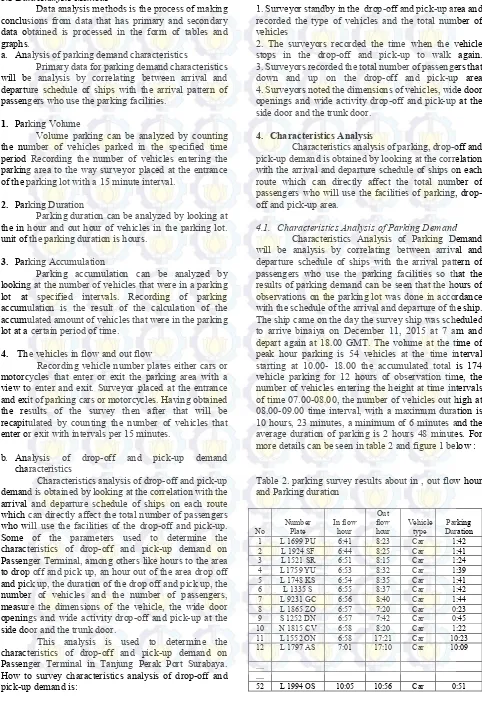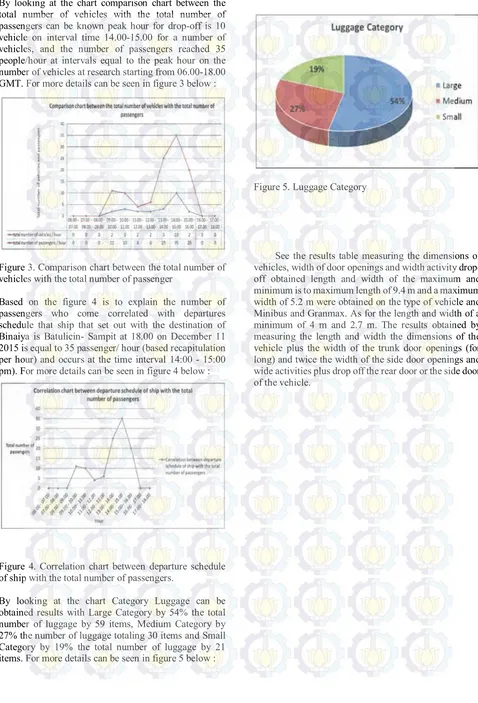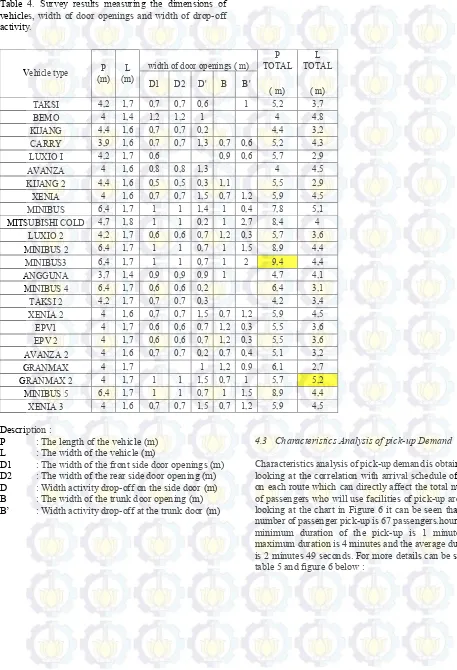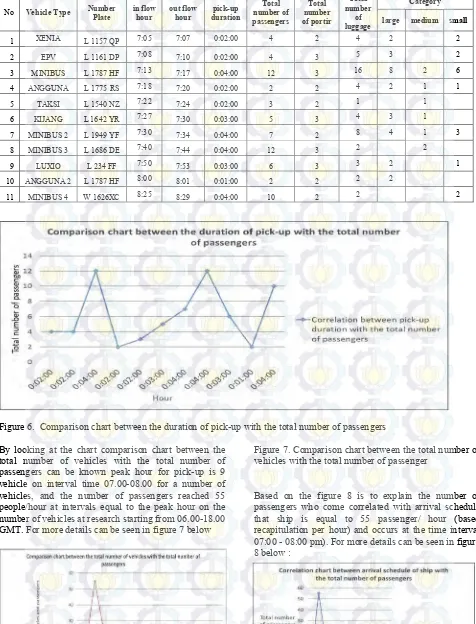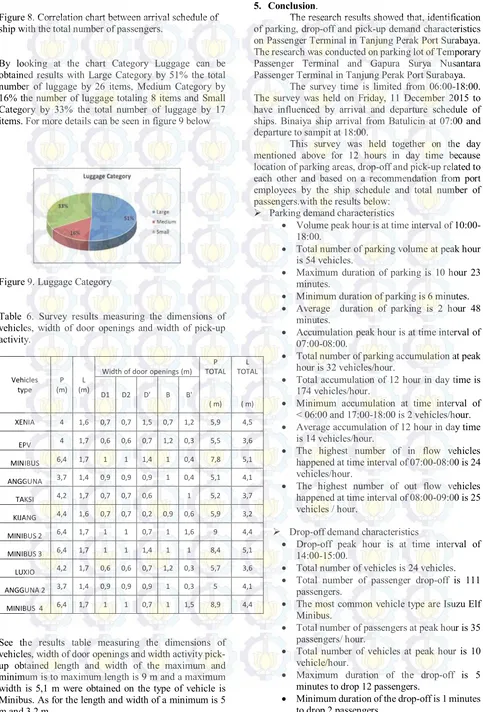Preliminary Identification of Parking, Drop-off and Pick-up Demand
Characteristics on Passenger Terminal in Tanjung Perak Port
Surabaya
Agit Eka Pambudi1, a *, Hitapriya Suprayitno2,b
1Department of Civil Engineering, Institute of Technology Sepuluh Nopember, Surabaya, Indonesia 2 Department of Civil Engineering, Institute of Technology Sepuluh Nopember, Surabaya, Indonesia
a[email protected], b[email protected]
Abstract
The port is a very important infrastructure for the economic and social life of the region. Passenger Terminal in Tanjung Perak Port Surabaya is the most luxurious ocean liner passenger terminal in Indonesia. Passengers flow on Passenger Terminal increase considerably because the ship fares are relatively more affordable. Based on the trend above, it can be estimated that passenger flow will increase from year to year. The purpose of the research is to know the characteristics of parking, drop-off and pick-up demand on Passenger Terminal in Tanjung Perak Port Surabaya. Parking demand characteristics are peak hour, parking volume, parking duration, parking accumulation, the vehicles in flow and out flow. Drop-off demand characteristics are peak hour, total number of vehicles, total number of passengers, vehicle type, vehicle arrival hour, vehicle departure hour and drop-off duration. Pick-up demand characteristics are peak hour, total number of vehicles, total number of passengers, vehicle type, vehicle arrival hour, vehicle departure hour and pick-up duration. Data collection methods is influenced by arrival and departure schedule of ships and passenger arrival pattern of the ship's departure schedule and pattern of departing passengers leaving the terminal to the ship arrival schedule. The research results showed that, for parking demand characteristics are volume peak hour is at time interval of 10.00- 18.00, total number of parking volume at peak hour is 54 vehicles, average duration of parking is 2 hours 48 minutes, accumulation peak hour is at time interval of 7.00- 8.00 am, total number of parking accumulation at peak hour is 32 vehicles/hour, the highest number of vehicles in flow happened at time interval of 07:00-08:00 am is 24 vehicle/hour, the highest number of vehicles out flow happened at time interval of 08:00-09:00 am is 25 vehicles / hour. For drop-off demand characteristics are drop-off peak hour is at time interval of 14.00-15.00 pm, total number of passengers and vehicles at peak hour is 35 passengers/ hour and 10 veh/hour at 14.00-15.00 pm, average duration of the drop-off is 2 minutes 24 seconds. For pick-up demand characteristics are Pick-up peak hour is at time interval of 7.00-8.00 am, total number of passengers and vehicles at the time of peak hour pick-up is 55 passengers/ hour and 9 veh/hour at 7.00-8.00 am. Average duration of the pick-up is 2 minutes 49 seconds.
Keywords: Parking demand characteristic, drop-off demand characteristic, pick-up demand characteristic, sea port passenger terminal
1. Introduction
Indonesia is an archipelago country. Therefore, it is usually called as maritim state. Sea transport plays an important role and one of the backbone of the Indonesian economy. Ports are supporting infrastructure that is essential for economic and social life of a region. The port serve relationship among islands and to foreign countries.
Port of Tanjung Perak is the second largest port in Indonesia after the Port of Tanjung Priok in Jakarta. This port is of the basiest ports in Indonesia due to the economy activity and the interest of the people who will travel to pass through the sea lanes that cause to increased flow of passengers on a periodic basis
The port of Tanjung Perak has two passenger terminals that is Temporary Passenger Terminal and Gapura Surya Nusantara passenger Terminal which is the most luxurious ocean liner passenger terminal in Indonesia. Passengers flow on Passenger Terminal increase considerably because the ship fares are relatively more affordable. Based on the trend above, it can be estimated that passenger flow will increase from year to year.The purpose of the research is to know the characteristics of parking, drop-off and pick-up demand on Passenger Terminal in Tanjung Perak Port Surabaya.
2. Literature Review
2.1 Parking Space
Parking space is the size of the effective area for placing vehicles (passenger cars, bus or truck, and motorcycles), including free space and wide opening doors [1]. Parking Space Determination Unit based on:
a. The dimensions of a standard vehicle for passenger cars.
b. Free space vehicle parking
c. The width of the vehicle door openings.
Determination of the parking space are classified into 3 groups as in the table below:
2.2 Characteristics of Parking Demand
Characteristics of Parking intended as the basic properties that provide an assessment of parking services and parking problems that occur in the study sites. Based on the characteristics of parking, parking will be known condition that occurs at the site of research that include, among others [3]:
a. Parking Volume
Parking volume is the number of vehicles that occupy or are at the parking area in a given time period [8].
The volume of Parking = ∑ vehicle of parking at specific periods of time. (1)
b. Parking Duration
Duration of Parking describe the length of time a vehicle parked in a parking area which is expressed in units of time. Of the vehicle based on the number of recording in flow and out flow hour the importance of the duration of each vehicle parking lot [2].
Duration of Parking = T out – T in (2)
Having obtained the duration of parking for each vehicle in one day, it can be calculated the average duration of the day in the following manner [4]:
̅ =∑( . )∑ (3)
xi = the duration of each vehicle parking
fi = frequency/number of vehicles for the duration of the f = total of vehicles in one day
c. Parking Accumulation
The accumulation of parking is a number of vehicles were at a parking lot at a specific time interval. Information obtained by way of summing up the accumulated previous parking vehicles coupled with a number of vehicles that enter as well as reduced by the number of vehicles that come out [2].
Accumulation of Parking = X + Ei – Ex (4) X = ∑ Accumulation of previous vehicles Ei = ∑ Vehicle entry
Ex = ∑ Vehicle out
2.3 Characteristics of drop-off and pick-up demand Drop-off and pick-up zone is a place or area to be used for vehicles to drop-off and pick-up passengers [5]. The drop-off and pick-up area is the meeting point between the port terminal building and the ground transportation system. The length of the drop-off and pick-up lane needed is determined by the type and volume of the vehicles which are expected to occur in the peak hour [6].
Special lanes for drop-off and pick-up the passenger is needed whether using private vehicles, taxis, and buses, so that passengers do not have to walk too far from the vehicle stops. In general, the length of each vehicle that is varied for passenger cars is 7.6 m, for a
taxi is 6 m, and buses is 15 m. To approximate passenger car stop time is 2-4 minutes, a taxi for less than 2-4 minutes, and buses is 15 to 25 minutes [6][8].
3. Methods
The method of the data analysis in this research is the method of direct field surveys with correlating between arrival and departure schedules of ships routes with the total of passengers and vehicles will use the parking facilities, drop-off and pick-up area, so that it can be known the characteristics of parking, drop-off and
- Number of employees Passenger Terminal - Passenger Terminal Layout
2. PrimaryData
Namely data obtained directly from the field. Primary data is needed in this analysis are:
a. Total number of vehicle which parking, drop-off and pick-up is recording the total number of vehicle parking, drop-off and pick-up and registration of license plates on vehicles early going in and out of the parking lot Passenger Terminal Port of Tanjung Perak. The total number of vehicles parking, drop-off and pick-up is greatly influenced by the arrival and departure schedules on each - each ship's route. b. The total number of passengers at the parking area, drop-off and pick-up passengers at Terminal Passengers namely by noting the number of passengers who use the parking facility, drop off and pick up with recaps of time perhour.
c. Hours vehicles enter and exit the parking area and the drop-off and pick-up passengers to obtain parking duration, drop-off and pick-up.
d. The dimensions of the vehicle, the wide opening side doors and trunk and wide activity drop-off and pick-up is taken directly in the field at the time the vehicle started to go and stop at area drop-off and pick-up. At the time of recording or survey surveyor recommended carrying survey equipment as follows:
- Stationery(clipboard, pencil, etc.) - Gauge length (walking measure). - Stopwatch
3.2 Data Analysis Methods
Data analysis methods is the process of making conclusions from data that has primary and secondary data obtained is processed in the form of tables and graphs.
a. Analysis of parking demand characteristics
Primary data for parking demand characteristics will be analysis by correlating between arrival and departure schedule of ships with the arrival pattern of passengers who use the parking facilities.
1. Parking Volume
Volume parking can be analyzed by counting the number of vehicles parked in the specified time period Recording the number of vehicles entering the parking area to the way surveyor placed at the entrance of the parking lot with a 15 minute interval.
2. Parking Duration
Parking duration can be analyzed by looking at the in hour and out hour of vehicles in the parking lot. unit of the parking duration is hours.
3. Parking Accumulation
Parking accumulation can be analyzed by looking at the number of vehicles that were in a parking lot at specified intervals. Recording of parking accumulation is the result of the calculation of the accumulated amount of vehicles that were in the parking lot at a certain period of time.
4. The vehicles in flow and out flow
Recording vehicle number plates either cars or motorcycles that enter or exit the parking area with a view to enter and exit. Surveyor placed at the entrance and exit of parking cars or motorcycles. Having obtained the results of the survey then after that will be recapitulated by counting the number of vehicles that enter or exit with intervals per 15 minutes.
b. Analysis of drop-off and pick-up demand characteristics
Characteristics analysis of drop-off and pick-up demand is obtained by looking at the correlation with the arrival and departure schedule of ships on each route which can directly affect the total number of passengers who will use the facilities of the drop-off and pick-up. Some of the parameters used to determine the characteristics of drop-off and pick-up demand on Passenger Terminal, among others like hours to the area to drop off and pick up, an hour out of the area drop off and pick up, the duration of the drop off and pick up, the number of vehicles and the number of passengers, measure the dimensions of the vehicle, the wide door openings and wide activity drop-off and pick-up at the side door and the trunk door.
This analysis is used to determine the characteristics of drop-off and pick-up demand on Passenger Terminal in Tanjung Perak Port Surabaya. How to survey characteristics analysis of drop-off and pick-up demand is:
1. Surveyor standby in the drop-off and pick-up area and recorded the type of vehicles and the total number of vehicles
2. The surveyors recorded the time when the vehicle stops in the drop-off and pick-up to walk again. 3. Surveyors recorded the total number of passengers that down and up on the drop-off and pick-up area 4. Surveyors noted the dimensions of vehicles, wide door openings and wide activity drop-off and pick-up at the side door and the trunk door.
4. Characteristics Analysis
Characteristics analysis of parking, drop-off and pick-up demand is obtained by looking at the correlation with the arrival and departure schedule of ships on each route which can directly affect the total number of passengers who will use the facilities of parking, drop-off and pick-up area.
4.1. Characteristics Analysis of Parking Demand Characteristics Analysis of Parking Demand will be analysis by correlating between arrival and departure schedule of ships with the arrival pattern of passengers who use the parking facilities so that the results of parking demand can be seen that the hours of observations on the parking lot was done in accordance with the schedule of the arrival and departure of the ship. The ship came on the day the survey ship was scheduled to arrive binaiya on December 11, 2015 at 7 am and depart again at 18.00 GMT. The volume at the time of peak hour parking is 54 vehicles at the time interval starting at 10.00- 18.00 the accumulated total is 174 vehicle parking for 12 hours of observation time, the number of vehicles entering the height at time intervals of time 07.00-08.00, the number of vehicles out high at 08.00-09.00 time interval, with a maximum duration is 10 hours, 23 minutes, a minimum of 6 minutes and the average duration of parking is 2 hours 48 minutes. For more details can be seen in table 2 and figure 1 below :
Table 2. parking survey results about in , out flow hour and Parking duration
No Number Plate In flow hour
Out flow
hour Vehicle type Duration Parking
Figure 1. comparison chart between total number of vehicle in flow and out flow, accumulation and parking volume
4.2 Characteristics Analysis of Drop-off Demand Characteristics analysis of drop-off demand is obtained by looking at the correlation with departure schedule of ships on each route which can directly affect the total number of passengers who will use facilities of drop-off area. By looking at the chart in Figure 2 it can be seen that total passenger drop-off activity is 111 passengers on the hours 9:30 to 15:48. The minimum duration of the drop-off is 1 minute, the maximum duration is 5 minutes and the average duration is 2 minutes 24 seconds. For more details can be seen in table 3 and figure 2 below :
Table 3. The survey results of drop-off demand
Figure 2. Comparison chart between the duration of drop-off with the total number of passengers
No Vehicle Type Number Plate in flow hour out flow hour duration drop-off number of total passengers
total number of portir
total number
of luggage
category
large medium small
1 TAKSI L 2341 RO 9:30 9:32 0:02:00 4 2 2 2
2 BEMO L 1213 TS 9:45 9:48 0:03:00 7 3 5 4 1
3 KIJANG L 156 SN 10:03 10:05 0:02:00 3 2 3 2 1
4 CARRY W 453 DC 10:42 10:45 0:03:00 4 3 4 3 1
5 LUXIO L 1187 TR 10:55 10:56 0:01:00 3 2 2 2
6 AVANZA S 6675 DE 11:05 11:07 0:02:00 2 3 2 2
7 KIJANG 2 L 4356 QW 11:18 11:21 0:03:00 2 2 2 2
8 XENIA L 6554 ER 12:27 12:29 0:02:00 3 2 2 2
9 MINIBUS L 7645 RE 12:30 12:32 0:02:00 3 2 2 2
10 MITSUBISHI COLD L 3323 PO 13:40 13:43 0:03:00 7 3 8 3 1 4
11 LUXIO 2 W 8877 GT 13:44 13:46 0:02:00 6 3 3 3
12 MINIBUS 2 W 4344 RF 13:55 14:00 0:05:00 12 3 12 10 2
...
...
...
24 XENIA 3 L 1960 WV 15:45 15:48 0:03:00 8 3 10 5 1 4
By looking at the chart comparison chart between the total number of vehicles with the total number of passengers can be known peak hour for drop-off is 10 vehicle on interval time 14.00-15.00 for a number of vehicles, and the number of passengers reached 35 people/hour at intervals equal to the peak hour on the number of vehicles at research starting from 06.00-18.00 GMT. For more details can be seen in figure 3 below :
Figure 3. Comparison chart between the total number of vehicles with the total number of passenger
Based on the figure 4 is to explain the number of passengers who come correlated with departures schedule that ship that set out with the destination of Binaiya is Batulicin- Sampit at 18.00 on December 11 2015 is equal to 35 passenger/ hour (based recapitulation per hour) and occurs at the time interval 14:00 - 15:00 pm). For more details can be seen in figure 4 below :
Figure 5. Luggage Category
See the results table measuring the dimensions of vehicles, width of door openings and width activity drop-off obtained length and width of the maximum and minimum is to maximum length of 9.4 m and a maximum width of 5.2 m were obtained on the type of vehicle and Minibus and Granmax. As for the length and width of a minimum of 4 m and 2.7 m. The results obtained by measuring the length and width the dimensions of the vehicle plus the width of the trunk door openings (for long) and twice the width of the side door openings and wide activities plus drop off the rear door or the side door of the vehicle.
Figure 4. Correlation chart between departure schedule of ship with the total number of passengers.
Table 4. Survey results measuring the dimensions of vehicles, width of door openings and width of drop-off activity.
Description :
P : The length of the vehicle (m) L : The width of the vehicle (m)
D1 : The width of the front side door openings (m) D2 : The width of the rear side door opening (m) D : Width activity drop-off on the side door (m) B : The width of the trunk door opening (m) B’ : Width activity drop-off at the trunk door (m)
4.3 Characteristics Analysis of pick-up Demand
Characteristics analysis of pick-up demand is obtained by looking at the correlation with arrival schedule of ships on each route which can directly affect the total number of passengers who will use facilities of pick-up area. By looking at the chart in Figure 6 it can be seen that total number of passenger pick-up is 67 passengers.hours. The minimum duration of the pick-up is 1 minute, the maximum duration is 4 minutes and the average duration is 2 minutes 49 seconds. For more details can be seen in table 5 and figure 6 below :
Vehicle type (m) P (m) L width of door openings ( m) P
TOTAL TOTAL L
D1 D2 D' B B'
( m) ( m) TAKSI 4,2 1,7 0,7 0,7 0,6 1 5,2 3,7
BEMO 4 1,4 1,2 1,2 1 4 4,8
KIJANG 4,4 1,6 0,7 0,7 0,2 4,4 3,2 CARRY 3,9 1,6 0,7 0,7 1,3 0,7 0,6 5,2 4,3 LUXIO I 4,2 1,7 0,6 0,9 0,6 5,7 2,9
AVANZA 4 1,6 0,8 0,8 1,3 4 4,5
KIJANG 2 4,4 1,6 0,5 0,5 0,3 1,1 5,5 2,9 XENIA 4 1,6 0,7 0,7 1,5 0,7 1,2 5,9 4,5 MINIBUS 6,4 1,7 1 1 1,4 1 0,4 7,8 5,1 MITSUBISHI COLD 4,7 1,8 1 1 0,2 1 2,7 8,4 4
LUXIO 2 4,2 1,7 0,6 0,6 0,7 1,2 0,3 5,7 3,6 MINIBUS 2 6,4 1,7 1 1 0,7 1 1,5 8,9 4,4
MINIBUS3 6,4 1,7 1 1 0,7 1 2 9,4 4,4
ANGGUNA 3,7 1,4 0,9 0,9 0,9 1 4,7 4,1 MINIBUS 4 6,4 1,7 0,6 0,6 0,2 6,4 3,1 TAKSI 2 4,2 1,7 0,7 0,7 0,3 4,2 3,4 XENIA 2 4 1,6 0,7 0,7 1,5 0,7 1,2 5,9 4,5 EPV1 4 1,7 0,6 0,6 0,7 1,2 0,3 5,5 3,6 EPV 2 4 1,7 0,6 0,6 0,7 1,2 0,3 5,5 3,6 AVANZA 2 4 1,6 0,7 0,7 0,2 0,7 0,4 5,1 3,2
GRANMAX 4 1,7 1 1,2 0,9 6,1 2,7
Table 5. The survey results of pick-up demand
Figure 6. Comparison chart between the duration of pick-up with the total number of passengers
By looking at the chart comparison chart between the total number of vehicles with the total number of passengers can be known peak hour for pick-up is 9 vehicle on interval time 07.00-08.00 for a number of vehicles, and the number of passengers reached 55 people/hour at intervals equal to the peak hour on the number of vehicles at research starting from 06.00-18.00 GMT. For more details can be seen in figure 7 below
Figure 7. Comparison chart between the total number of vehicles with the total number of passenger
Based on the figure 8 is to explain the number of passengers who come correlated with arrival schedule that ship is equal to 55 passenger/ hour (based recapitulation per hour) and occurs at the time interval 07:00 - 08:00 pm). For more details can be seen in figure 8 below :
No Vehicle Type Number Plate in flow hour out flow hour duration pick-up number of Total passengers
Total number of portir
Total number
of luggage
Category
large medium small
1 XENIA L 1157 QP 7:05 7:07 0:02:00 4 2 4 2 2
2 EPV L 1161 DP 7:08 7:10 0:02:00 4 3 5 3 2
3 MINIBUS L 1787 HF 7:13 7:17 0:04:00 12 3 16 8 2 6
4 ANGGUNA L 1775 RS 7:18 7:20 0:02:00 2 2 4 2 1 1
5 TAKSI L 1540 NZ 7:22 7:24 0:02:00 3 2 1 1
6 KIJANG L 1642 YR 7:27 7:30 0:03:00 5 3 4 3 1
7 MINIBUS 2 L 1949 YF 7:30 7:34 0:04:00 7 2 8 4 1 3
8 MINIBUS 3 L 1686 DE 7:40 7:44 0:04:00 12 3 2 2
9 LUXIO L 234 FF 7:50 7:53 0:03:00 6 3 3 2 1
10 ANGGUNA 2 L 1787 HF 8:00 8:01 0:01:00 2 2 2 2
Figure 8. Correlation chart between arrival schedule of ship with the total number of passengers.
By looking at the chart Category Luggage can be obtained results with Large Category by 51% the total number of luggage by 26 items, Medium Category by 16% the number of luggage totaling 8 items and Small Category by 33% the total number of luggage by 17 items. For more details can be seen in figure 9 below
Figure 9. Luggage Category
Table 6. Survey results measuring the dimensions of vehicles, width of door openings and width of pick-up activity.
See the results table measuring the dimensions of vehicles, width of door openings and width activity pick-up obtained length and width of the maximum and minimum is to maximum length is 9 m and a maximum width is 5,1 m were obtained on the type of vehicle is Minibus. As for the length and width of a minimum is 5 m and 3,2 m..
5. Conclusion.
The research results showed that, identification of parking, drop-off and pick-up demand characteristics on Passenger Terminal in Tanjung Perak Port Surabaya. The research was conducted on parking lot of Temporary Passenger Terminal and Gapura Surya Nusantara Passenger Terminal in Tanjung Perak Port Surabaya. The survey time is limited from 06:00-18:00. The survey was held on Friday, 11 December 2015 to have influenced by arrival and departure schedule of ships. Binaiya ship arrival from Batulicin at 07:00 and departure to sampit at 18:00.
This survey was held together on the day mentioned above for 12 hours in day time because location of parking areas, drop-off and pick-up related to each other and based on a recommendation from port employees by the ship schedule and total number of passengers.with the results below:
Parking demand characteristics
Volume peak hour is at time interval of 10:00- 18:00.
Total number of parking volume at peak hour is 54 vehicles.
Maximum duration of parking is 10 hour 23 minutes.
Minimum duration of parking is 6 minutes.
Average duration of parking is 2 hour 48 minutes.
Accumulation peak hour is at time interval of 07:00-08:00.
Total number of parking accumulation at peak hour is 32 vehicles/hour.
Total accumulation of 12 hour in day time is 174 vehicles/hour.
Minimum accumulation at time interval of < 06:00 and 17:00-18:00 is 2 vehicles/hour.
Average accumulation of 12 hour in day time is 14 vehicles/hour.
The highest number of in flow vehicles happened at time interval of 07:00-08:00 is 24 vehicles/hour.
The highest number of out flow vehicles happened at time interval of 08:00-09:00 is 25 vehicles / hour.
Drop-off demand characteristics
Drop-off peak hour is at time interval of 14:00-15:00.
Total number of vehicles is 24 vehicles.
Total number of passenger drop-off is 111 passengers.
The most common vehicle type are Isuzu Elf Minibus.
Total number of passengers at peak hour is 35 passengers/ hour.
Total number of vehicles at peak hour is 10 vehicle/hour.
Maximum duration of the drop-off is 5 minutes to drop 12 passengers.
Average duration of the drop-off is 2 minutes 24 seconds.
Vehicle dimensions for drop-off activity is as follow: length variation is 4 m to 9,4 m, width variation is 2,7 m to 5,2 m.
In term of Luggage size distribution, it has been noted that total number of large luggage is 59 item means 54% of all, total number of medium luggage is 30 item means 27% of all, and total number of small luggage is 21 item means 19% of all.
Pick-up demand characteristics
Pick-up peak hour is at time interval of 07:00-08:00.
Total number of vehicles is 11 vehicles.
Total number of passenger pick-up is 67 passengers.
The most common vehicle type are Isuzu Elf Minibus.
Total number of passengers at peak hour is 55 passengers/ hour.
Total number of vehicles at peak hour is 9 veh/ hour.
Maximum duration of the pick-up is 4 minutes to pick-up 12 passengers.
Minimum duration of the pick-up is 1 minutes to pick-up 2 passengers.
Average duration of the pick-up is 2 minutes 49 seconds.
Vehicle dimensions for pick-up activity is as follow: length variation is 5 m to 9 m, width variation is 3,2 m to 5,1 m.
In term of Luggage size distribution, it has been noted total number of large luggage is 26 item means 51% of all, Total number of medium luggage is 8 item means 16% of all, and total number of small luggage is 17 item means 33% of all.
6. References
[1] Anonim, Pedoman Teknis Penyelenggaraan Fasilitas Parkir, Direktorat Jenderal Perhubungan Darat, Departemen Perhubungan, Jakarta, 1996.
[2] Anonim, Penyusunan Standar Pelayanan Perpakiran, Direktorat Jenderal Perhubungan Darat, Departemen Perhubungan, Jakarta, 2009.
[3] Hobbs, F.D., Traffic Planning and Engineering, Second Edition Pergamon Press, England, 1979.
[4] Oppenlander, J.C., Manual of Traffic Engineering Studies, 4th edition, Institute of Traffic Transportation Engineering, Washington.DC, 1976.
[5] Tjakranegara, Soegijatna, Hukum Pengangkutan Barang dan Penumpang, Rineka Cipta, Jakarta, 1995.
[6] Hafizah, Nafilah, 2015, Evaluasi Karakteristik Penggunaan Moda Akses Bandar Udara Juanda
Surabaya Sebagai Dasar Usulan Pengadaan Transportasi Massal Menuju Bandara. Skripsi Transportasi, Surabaya.
[7] Horonjeff, R., Perencanaan dan Perancangan Bandara, Erlangga, Jakarta, 1988.

